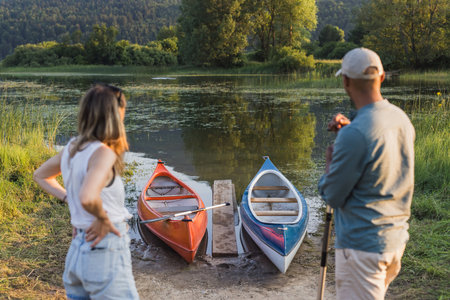Understanding UK Waters: From Canals to Coastlines
Keen kayakers in the UK are blessed with a tapestry of waterways, each woven with its own character and history. From the tranquil, tree-lined canals meandering through sleepy villages, to the wild, salt-laden air of rugged coastlines and dramatic lochs shimmering beneath distant hills, every stretch of water offers a unique experience. The gentle ripple of a narrow canal in the Midlands contrasts starkly with the brisk tidal surges found along Cornwall’s Atlantic shore. For those who seek adventure or solace upon these waters, understanding their quirks is essential. Regional regulations also play a significant part—some rivers require permits, while certain lochs are protected habitats demanding extra care. The open sea around the British Isles brings its own challenges too, with tides that can change direction and strength within hours. To paddle here is to become attuned to the rhythm of Britain’s natural world, and to respect both its beauty and its boundaries. Whether you’re slipping quietly under ancient stone bridges on the Thames or bracing against sea spray off the Northumberland coast, every journey demands knowledge not just of your craft, but of the living waters themselves.
2. Mastering Tidal Navigation and Weather Awareness
Kayaking in the UK is a unique dance with ever-changing tides and temperamental weather, where understanding nature’s rhythms becomes as essential as your paddle. The British coastline and inland waterways are shaped by powerful tidal currents, shifting winds, and sudden showers—each element demanding respect and knowledge from every kayaker. Before launching onto the water, take time to interpret tide tables specific to your chosen area. These local charts reveal when tides will ebb and flow, their heights, and any notorious tidal races that could challenge even seasoned paddlers. Equally crucial is a keen awareness of the weather; reading detailed Met Office forecasts allows you to anticipate wind direction, potential rainfall, and temperature shifts that influence both safety and enjoyment on the water.
Interpreting Tide Tables: A UK Kayaker’s Essential Skill
Tide tables might seem cryptic at first glance, but they are indispensable for trip planning. They not only indicate high and low tide times but also help you gauge water depth changes along rivers and estuaries. Understanding these patterns helps prevent being stranded on mudflats or caught in swift tidal flows.
| Key Tide Table Terms | Meaning |
|---|---|
| High Water (HW) | The peak of the tide, when water is highest |
| Low Water (LW) | The lowest point of the tide |
| Tidal Range | The difference between HW and LW—a large range means strong currents |
| Tidal Race | Fast-moving water caused by tides funnelling through narrow spaces |
Weather Forecasts: Reading Beyond Rainclouds
In Britain, weather can turn on a sixpence. Regularly checking trusted sources like the Met Office ensures you’re prepared for sudden squalls or welcome sunshine. Pay special attention to wind strength and direction; a gentle breeze can become a formidable headwind across open lakes or sea passages.
How Tides and Weather Influence Your Kayaking Plans
Your route, launch time, and return must be shaped by both tidal cycles and forecast conditions. For instance, setting out with an incoming tide may offer an easier paddle upriver, while planning your trip around slack water minimises battling against strong currents. Always leave room for flexibility in your plans—nature in the UK rarely sticks to a script.
By mastering these quintessential British skills—interpreting tide tables, forecasting weather patterns, and adapting accordingly—you’ll unlock safer adventures and discover a deeper connection to the watery landscapes that make UK kayaking truly unforgettable.

3. Essential Kayaking Techniques for British Conditions
In the heart of Britain, where rivers meander past rolling hills and coastal waters shift with the breath of the Atlantic, mastering core kayaking techniques is not just a matter of skill—it’s an art form shaped by our unique and sometimes capricious weather. To truly thrive in these waters, every kayaker must cultivate a repertoire that goes beyond the basics.
Paddling Skills for Choppy Waters
The British climate often means unpredictable gusts and swift changes in water conditions. Solid forward and sweep strokes are your foundation, but learning to feather your paddle and adapt your grip can make all the difference when facing a bracing easterly wind or negotiating narrow waterways lined with ancient willows. Practising draw strokes, both on the move and stationary, allows you to navigate tight spaces—an essential for winding English rivers and bustling Scottish lochs.
Bracing: Staying Upright When It Matters Most
With weather turning at a moment’s notice, perfecting your low and high bracing techniques becomes vital. These manoeuvres help you maintain balance when surprise waves roll in or when a sudden squall sweeps across a previously placid lake. In true British fashion, resilience is key; regular practice in less-than-ideal conditions will build both muscle memory and confidence.
Self-Rescue Methods: Preparedness is Everything
No one relishes a chilly dip in the River Wye or North Sea, but being adept at self-rescue ensures a minor mishap doesn’t turn into something more serious. Learn to perform efficient wet exits and master the re-entry techniques best suited to your kayak type—be it a traditional sit-in or nimble sit-on-top. The paddle float rescue is particularly practical for solo outings on brisk mornings, while buddy-assisted rescues become invaluable when paddling as part of a group along Cornwall’s rugged coast.
The Importance of Regular Practice
British kayakers know that conditions vary dramatically from one day to the next. Carving out time for regular practice sessions—especially during those misty dawn hours or golden evenings—is not only good for honing technique but also for soaking up the quiet beauty of our waterways. Whether it’s embracing rain-speckled mornings or breezy afternoons, each outing builds the instinctive skills needed to kayak safely and gracefully, whatever the weather throws your way.
4. River Etiquette and ‘Right of Way’ in the UK
Gliding along the winding rivers of Britain is a privilege that comes with its own set of unspoken rules and customs. As a kayaker in the UK, understanding river etiquette is more than a matter of politeness—it’s essential for safety, harmony, and respect for both people and nature. The waterways are shared by paddlers, anglers casting their lines in patient hope, narrowboats meandering on leisure journeys, and an abundance of wildlife thriving along the banks. Navigating these shared spaces with courtesy ensures that everyone enjoys their time on the water.
The Unwritten Code: Courtesy Among Waterway Users
British river culture is steeped in tradition, where a nod or cheerful “Good morning!” can go a long way. When approaching others—whether passing fishermen, other kayakers, or canal boats—slowing your pace and offering a smile signals both awareness and consideration. This gentle communication helps foster a sense of camaraderie unique to the UK’s paddling scene.
Understanding Right of Way
| User Type | Right of Way |
|---|---|
| Narrowboats & Powered Craft | Generally have right of way due to limited manoeuvrability |
| Anglers | Paddlers should give wide berth to avoid disturbing fishing lines and swims |
| Wildlife (e.g., swans, ducks) | Always yield; slow down or stop if necessary to avoid disturbance |
| Other Kayakers/Canoeists | Keep to the right (starboard) when passing head-on; overtake on the left (port) when safe |
Legal Guidelines to Remember
- Check access rights: Not all rivers in England and Wales have open access for paddling—be sure to research local bylaws and obtain necessary permissions.
- Respect private property: Launch only from designated public points unless landowner permission is granted.
- Follow environmental codes: Avoid damaging riverbanks, disturbing nesting birds, or leaving litter behind.
Cultivating good river etiquette not only preserves the tranquility of the British countryside but also upholds traditions cherished by generations. A little mindfulness goes a long way—ensuring your paddle leaves no ripples of discord as you journey through these storied waters.
5. Safety and Communication: Staying Prepared on British Waterways
Before you set out to paddle the meandering rivers of Devon or the salt-kissed estuaries of Northumberland, it’s vital to equip yourself with a robust safety mindset. The unpredictable nature of UK waters demands more than just enthusiasm; it calls for preparation rooted in local knowledge and tried-and-true practices.
Essential Safety Gear for the UK Kayaker
Your kit should always include a well-fitted buoyancy aid, not just as a formality but as your first line of defence against capricious tides or sudden weather shifts. A waterproof VHF radio or a mobile phone encased in a dry bag can be a lifeline if you need to summon help. Don’t forget a whistle for signalling, especially in foggy or low-visibility conditions that are all too common along British coasts and rivers.
Navigating Communication Procedures
The art of communication on British waterways is steeped in both courtesy and practicality. Always inform someone ashore about your planned route and expected return time—a simple habit that can make all the difference in an emergency. If kayaking in groups, agree on hand signals before you launch; this silent language ensures everyone’s safety when words are snatched away by wind or current.
Local Emergency Contacts: Know Before You Go
Each region has its own rescue services—take time to note down relevant contacts such as HM Coastguard (dial 999 and ask for the Coastguard), local harbour masters, or river authorities. Downloading apps like What3Words can also help pinpoint your location with precision should you need assistance. By weaving these precautions into your routine, you’ll paddle with confidence, ready to savour every shimmering ripple and sunlit bend along the UK’s storied waterways.
6. Environmental Stewardship: Paddling with Purpose
Embracing the role of environmental steward is an essential skill for every UK kayaker, weaving responsibility into the very fabric of your waterway adventures. British rivers, lochs, and estuaries are not only playgrounds for paddlers but also delicate habitats that brim with life—kingfishers flashing through willow-lined banks, otters slipping beneath the surface, wildflowers scenting the breeze. To paddle here is to be a guest in a living landscape shaped by centuries of natural beauty and local heritage.
Leave No Trace on Land and Water
Practising ‘Leave No Trace’ principles is fundamental. Every crisp packet tucked away, every bit of kit checked for invasive seeds, and every campsite left as you found it helps preserve these waterways for generations to come. Be mindful of bank erosion—avoid dragging boats unnecessarily—and resist the temptation to disturb nesting birds or aquatic plants. Even small actions echo through the ecosystem.
Support Local Conservation
Many stretches of river in the UK are protected or managed by passionate local groups. Supporting their work—whether through membership, volunteering, or simply respecting signage and seasonal access restrictions—ensures your paddling adventures contribute to ongoing conservation efforts. Consider joining river clean-up days or participating in citizen science projects that track wildlife sightings and water quality.
Paddle with Purpose
Ultimately, environmental stewardship infuses every journey with deeper purpose. Each stroke becomes a promise to care for the watery paths we cherish—a gentle respect for misty mornings on the Thames or vibrant sunsets over Scottish lochs. By adopting mindful practices and supporting local initiatives, you help ensure the magic of Britain’s waterways endures, inviting future generations to experience their quiet wonder.

